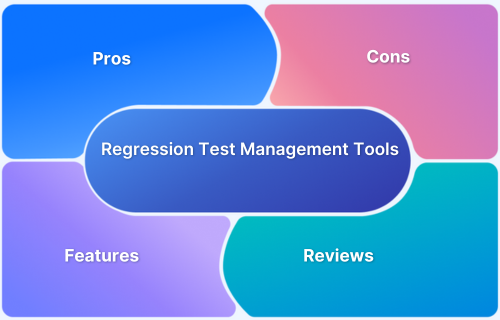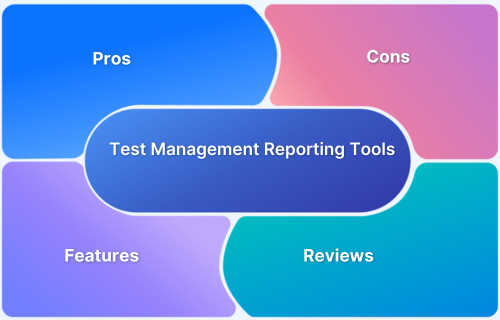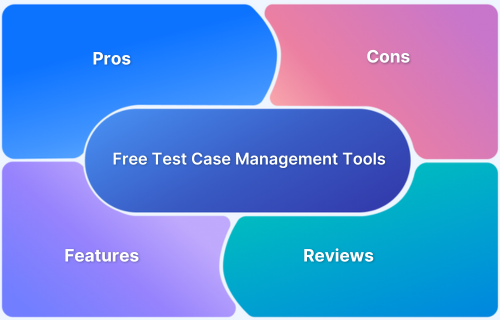Manual test management tools are essential for organizing, tracking, and executing manual testing processes in software development.
Overview
Best Manual Test Management Tools in 2025:
- BrowserStack Test Management: AI-driven manual and automated test authoring with real-time traceability and extensive integrations.
- PractiTest: End-to-end traceability and compliance with customizable dashboards in a cloud-native SaaS platform.
- Kualitee: Flexible, user-friendly manual test and defect management with real-time dashboards and API support.
- Testmo: Unified manual, exploratory, and automated test management emphasizing collaboration and analytics.
- Xray for Jira: Native Jira test case management with deep traceability and automated/manual execution workflows.
- Zephyr for Jira: Seamless Jira-based manual testing with real-time analytics and automation integration.
- TestRail: Robust manual test case repository with comprehensive reporting and enterprise-grade integrations.
- TestCollab: Simple collaborative manual test planning and execution with agile-centric integrations.
- QAComplete: Customizable manual workflows and defect linking with hybrid execution support.
- TestLodge: Easy-to-use manual test management designed for smaller teams with essential collaboration capabilities.
- Tuskr: Modern manual test case authoring and defect management with Jira integration and real-time reporting.
- Azure DevOps Test Plans: Integrated manual and exploratory test management deeply embedded in Azure DevOps ecosystem.
This article delves into the importance and features of manual test management tools, providing an overview of how they can streamline manual testing efforts and improve software quality.
What are Manual Test Management Tools?
Manual test management tools are software solutions that help teams plan, organize, execute, and track manual tests. These tools enable testers to create detailed test cases, execute them systematically, and log defects when issues arise.
By centralizing test case creation, execution tracking, and defect management, they ensure that manual testing is organized and aligned with project goals.
Additionally, manual test management tools often integrate with other testing or project management platforms, streamlining workflows and ensuring transparency throughout the development lifecycle.
Key Features of Manual Test Management Tools
Manual test management tools offer a variety of features to streamline the testing process, including:
- Test Case Management: Create, organize, and store test cases for easy access and execution, ensuring consistency across test cycles.
- Defect Tracking: Log, manage, and track defects, allowing teams to prioritize and resolve issues efficiently.
- Test Execution and Results Reporting: Execute tests and record results in real time, providing valuable insights into the status of the application and its quality.
- Collaboration and Communication: Facilitate communication between QA, development, and product teams, allowing for real-time updates, feedback, and issue resolution.
- Integration with Other Tools: Seamlessly integrate with other tools like Jira, TestRail, and CI/CD pipelines to provide a unified view of the testing process.
- Test Planning: Organize and schedule tests, ensuring the appropriate tests are executed in alignment with the development cycle.
- Traceability: Maintain traceability between test cases, requirements, and defects, ensuring comprehensive test coverage and compliance with project requirements.
Importance of Manual Test Management Tools
Manual test management tools are crucial for ensuring that the manual testing process is systematic, organized, and efficient. They provide several key benefits, including:
- Improved Organization: Centralized management of test cases and defects helps teams stay organized and focused, reducing the risk of missed tests or overlooked defects.
- Enhanced Collaboration: These tools provide a platform for cross-functional teams to collaborate, share test cases, and resolve issues, ensuring alignment between development and QA.
- Increased Efficiency: With structured workflows, real-time reporting, and defect tracking, manual testing becomes more efficient, allowing teams to focus on testing rather than administrative tasks.
- Visibility and Transparency: Test management tools provide clear, detailed reports and dashboards that give stakeholders real-time insights into testing progress, quality metrics, and defects, helping teams make informed decisions.
- Traceability and Compliance: For industries requiring detailed documentation (such as healthcare or finance), these tools ensure compliance by maintaining an audit trail of all test activities, ensuring full traceability between requirements, tests, and defects.
Must Read:Top 15 Manual Testing Tools
Top Manual Test Management Tools in 2025
In 2025, the top manual test management tools provide seamless integration with development workflows, enabling efficient test creation, execution, and defect tracking.
These tools enhance collaboration and ensure high-quality testing with real-time reporting and centralized test case management.
1. BrowserStack Test Management
BrowserStack Test Management is an AI-powered unified platform that accelerates manual and automated test creation, execution, and reporting with deep integrations and real-time insights.
It offers seamless integrations, real-time visibility through customizable dashboards, and advanced AI agents that streamline testing workflows for both manual and automated tests.
It supports teams of all sizes with a cloud infrastructure enabling fast, scalable testing on real devices.
Key Features
- AI-Powered Test Case Creation: Automatically generate comprehensive test cases from Product Requirement Documents (PRDs), user stories, or text prompts. AI also suggests enhancements to existing test cases, reducing manual effort significantly.
- Test Deduplication Agent: Detects exact or semantically similar test cases across your repository, providing intelligent recommendations for merging or removal to maintain a clean and efficient test suite.
- Low-Code Automated Test Authoring: Quickly convert manual test cases into low-code automated tests to accelerate automation adoption without requiring deep coding skills.
- Intelligent Test Selection Agent: Uses AI to identify and recommend the most relevant tests for execution, optimizing test runs and focusing on critical test coverage.
- Unified Test Management: Manage all manual and automated test cases in one centralized platform with full traceability from requirements to defects through seamless integrations with Jira, Azure DevOps, and more.
- Powerful Dashboard Analytics: Access customizable dashboards that offer real-time insights, track release status, monitor historical trends, and visualize testing metrics, including automation coverage.
- Shared Steps for Reusability: Mark repetitive test steps as shared within test cases to enhance reusability and save effort when creating or maintaining test cases.
- Quick Import & Custom Field Mapping: Import test cases rapidly from CSV files or existing management tools with automatic field mapping and on-the-fly custom field creation.
- AI-Powered Jira App with Two-Way Binding: Synchronize test cases and runs between BrowserStack Test Management and Jira, allowing management from both platforms with AI-driven assistance.
- Streamlined Manual and Automated Test Runs: Plan and execute test runs across manual and automated tests. Supports dynamic test inclusion and uploading automation results from frameworks like JUnit and BDD-JSON.
The free version of BrowserStack Test Management offers unlimited test cases, robust integrations, and real-time reporting capabilities.
Try BrowserStack Test Management
2. PractiTest
PractiTest is a SaaS test management solution offering end-to-end traceability, customizable dashboards, and collaborative workflows suited for regulated and complex projects. It supports manual and automated test operations in a single platform.
Key Features:
- Links requirements, tests, and defects for complete traceability and audit readiness.
- Customizable real-time dashboards visualize testing and release metrics.
- Integrates easily with popular automation tools and defect trackers.
- Supports hierarchical test organization to manage large testing projects.
Pros:
- Strong traceability fits compliance-heavy environments.
- Intuitive interface with rich reporting capabilities.
Cons:
- Initial setup and customization require time and expertise.
- Lacks advanced AI-assisted test authoring.
3. Kualitee
Kualitee is a flexible cloud and on-premise test management platform that includes defect tracking with real-time dashboards and API-driven automation integration.
Key Features:
- Provides comprehensive manual test and defect management.
- Maintains traceability by linking requirements to tests and defects.
- Presents real-time dashboards with comprehensive quality metrics.
- Supports API triggers for automation workflows within CI/CD pipelines.
Pros:
- User-friendly interface with both free and premium plans.
- Supports multiple deployment options, including self-hosting.
Cons:
- API and automation features are less extensive than advanced competitors.
- Some third-party integrations require manual configuration.
4. Testmo
Testmo unifies manual, exploratory, and automated testing in a collaborative platform that offers powerful dashboards and broad integrations.
Key Features:
- Manages manual test cases, exploratory testing, and automation in one platform.
- Provides real-time analytics with customizable dashboards.
- Integrates natively with Jira and common CI/CD tools.
- Supports flexible workflows to accommodate agile and DevOps teams.
Pros:
- Comprehensive coverage of diverse testing needs.
- Strong collaboration and visibility features.
Cons:
- Automation tools are evolving and less mature.
- Onboarding complexity for larger organizations.
5. Xray for Jira
Xray is a native Jira test management app supporting manual and automated test execution with deep traceability from requirements to defects.
Key Features:
- Treats test cases as Jira issues for seamless integration.
- Maps requirements, tests, and defects within Jira’s ecosystem.
- Supports both manual and automated testing workflows.
- Provides REST API and CI/CD integration.
Pros:
- Fully embedded in Jira for cohesive project management.
- Advanced traceability and reporting features.
Cons:
- Performance and functionality depend on Jira hosting.
- May be restrictive for non-Jira-centric workflows.
Learn More:Xray Alternatives for Test Management
6. Zephyr for Jira
Zephyr integrates manual test management in Jira facilitating planning, execution, automation reporting, and multi-project support.
Key Features:
- Allows test case creation and execution natively in Jira.
- Offers real-time dashboards and test result analytics.
- Supports automation integration and requirement traceability.
- Provides REST API and CI/CD hooks.
Pros:
- Seamless for Jira users with Agile compatibility.
- Provides real-time visibility and coverage metrics.
Cons:
- Features depend on Jira version and hosting.
- Performance challenges with large-scale Jira instances.
Read More:Zephyr Alternatives for Test Management
7. TestRail
TestRail is a structured and scalable manual test management tool renowned for comprehensive reporting and strong integrations.
Key Features:
- Centralized repository for test case organization and reuse.
- Customizable dashboards and detailed reporting.
- Integrates with Jira and popular automation frameworks.
- Supports access controls and reusable test steps.
Pros:
- Excellent manual test management and reporting.
- Flexible integrations with a wide ecosystem.
Cons:
- No native AI-powered automation.
- Pricing can increase significantly at scale.
Read More: TestRail Alternatives for Test Management
8. TestCollab
TestCollab is a collaborative test management tool focused on ease of use and agile integration.
Key Features:
- Supports hierarchical test planning and execution.
- Integrates with Jira, Slack, and CI/CD pipelines.
- Offers REST API for automation triggers.
- Provides visual progress analytics.
Pros:
- Quick onboarding and simple interface.
- Good collaboration support for remote teams.
Cons:
- Limited advanced automation features.
- Basic reporting customization.
9. QAComplete
QAComplete offers a customizable environment for managing manual and automated tests with defect and requirement linking.
Key Features:
- Enables custom test suites and folder structures.
- Supports manual and automated test executions.
- Links defects and requirements within the platform.
- Provides insightful dashboards and reports.
Pros:
- Highly customizable workflows.
- Wide integrations with development tools.
Cons:
- Interface is considered dated by some users.
- Complex on-premise deployment.
10. TestLodge
TestLodge is an easy-to-use manual test management tool designed for small to midsize teams.
Key Features:
- Simple test case creation and suite organization.
- Basic reporting and test assignment.
- Integrates with Jira, Trello, and other issue trackers.
- Collaboration features for distributed teams.
Pros:
- Intuitive and fast setup.
- Affordable for smaller teams.
Cons:
- Limited support for automation.
- Not designed for large-scale or complex projects.
11. Tuskr
Tuskr focuses on providing a modern, easy-to-use manual test management environment with collaboration and traceability.
Key Features:
- Clean interface for test case authoring and execution.
- Requirement linkage and defect tracking.
- Real-time reporting dashboards.
- Integration with Jira and other common tools.
Pros:
- User-friendly with strong collaboration features.
- Supports traceability suitable for Agile teams.
Cons:
- Limited advanced features compared to enterprise tools.
- Smaller user base and community support.
Read More: 17 Best Test Management Tools For Jira
12. Azure DevOps Test Plans
Azure DevOps Test Plans is tightly integrated into the Microsoft DevOps ecosystem, offering manual and exploratory test management.
Key Features:
- Centralized manual and exploratory test case management.
- Full traceability linked to Azure Boards and pipelines.
- Automation integration for seamless CI/CD workflows.
- Advanced bug capture and reporting tools.
Pros:
- Ideal for organizations using Microsoft Azure DevOps stack.
- Real-time dashboards and quality insights.
Cons:
- Best value requires using broader Azure DevOps suite.
- Steeper learning curve for users outside Microsoft environments.
How to Choose the Right Manual Test Case Management Tool
Selecting the right manual test case management tool depends on several factors, including team size, project complexity, and integration needs. To choose the best tool for your team, consider the following:
- Integration Capabilities: Ensure the tool integrates seamlessly with your existing development, CI/CD, and project management tools like Jira or GitHub.
- Usability: The tool should have an intuitive interface that’s easy to navigate for both new and experienced testers, reducing the learning curve.
- Collaboration Features: Look for tools that enable real-time collaboration and sharing of test cases, results, and defects across teams.
- Reporting and Analytics: Ensure the tool provides detailed test reports and dashboards for tracking test progress, defects, and overall test coverage.
- Scalability: Choose a tool that can scale as your project grows, accommodating more test cases, users, and complex workflows.
- Customization: The tool should allow you to customize workflows, test case formats, and reporting templates to suit your specific needs.
- Cost and Support: Evaluate the cost of the tool, considering both upfront and long-term expenses. Additionally, ensure there is adequate customer support and resources available for troubleshooting.
Difference Between Automated and Manual Test Case Management Tools
Manual and automated test case management tools serve different purposes in the testing lifecycle. While manual testing requires human intervention, automated testing uses scripts and tools to perform tests automatically.
Below is a comparison of the two types of tools:
| Aspect | Automated Test Case Management Tools | Manual Test Case Management Tools |
| Test Execution | Executes tests automatically with minimal human intervention. | Requires manual execution of tests by testers. |
| Speed | Faster execution of tests, especially for repetitive tasks. | Slower execution due to manual effort and time spent on each test. |
| Error Reduction | Reduces human errors in test execution. | Prone to human errors during test execution and result logging. |
| Test Coverage | Capable of running a higher volume of tests and covering more scenarios. | Limited test coverage due to resource constraints and manual effort. |
| Cost | Higher initial setup and tool cost but reduces long-term costs through automation. | Lower upfront cost but requires more resources and time for manual execution. |
| Maintenance | Requires regular updates to automation scripts, particularly when the application changes. | Requires manual updates and changes, which can be time-consuming. |
| Integration with CI/CD | Seamlessly integrates with CI/CD pipelines for continuous testing. | Less suited for integration in CI/CD pipelines. |
| Collaboration | Primarily integrates with tools for collaboration like Slack or Jira. | Facilitates collaboration with shared test plans and results manually. |
Best Practices for Implementing Manual Test Case Management Tools
To ensure the effective implementation of manual test case management tools, follow these best practices:
- Align with Development Processes: Integrate test case management tools with existing workflows to synchronize testing with the project lifecycle.
- Centralize Test Case Storage: Store all test cases in one accessible location for consistency and easier updates.
- Standardize Test Case Formats: Create a template for test cases to ensure uniformity and streamline result analysis.
- Prioritize Test Case Execution: Use the tool to prioritize tests based on feature criticality, ensuring key tests are executed first.
- Use Real-Time Reporting: Leverage real-time reports to track progress, capture defects, and provide visibility to stakeholders.
- Train Your Team: Ensure your team is trained on tool features and workflows to enhance adoption and efficiency.
- Review and Optimize: Continuously review and improve test coverage and execution based on feedback and evolving needs.
Conclusion
Manual test case management tools are essential for organizing, tracking, and executing manual tests efficiently.
By providing centralized test case creation, execution tracking, and defect management, these tools ensure thorough, organized testing aligned with project goals.
As software development becomes increasingly complex, adopting the right test management tool enables teams to stay organized, reduce errors, and improve collaboration across departments. Following best practices for implementation will help teams maximize the value of these tools, ensuring high-quality, efficient software delivery.








